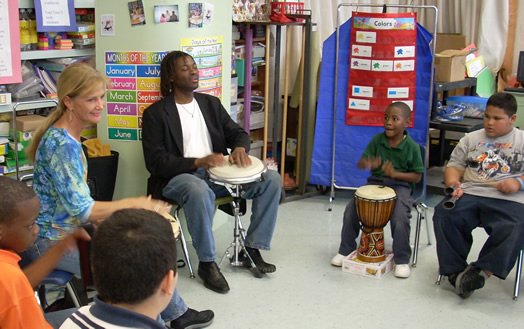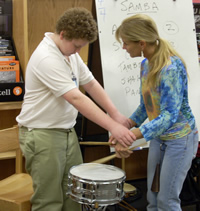Allegro
Shining a light
Working with blind musicians turns into a life-changing experience
Volume 113, No. 11December, 2013

Nanette Ledet, at left, with her blind and seeing-impaired students.
This is a story about how working with young, blind musicians changed my life. These children were some of my favorite students of my career. They taught me more than I will ever be able to teach them. They were working entirely from touch and memories, and all had highly developed skills in retention and playback of rhythms after hearing them once!
It all started with a conversation. I have a long-standing friendship with the jazz pianist Henry Butler, who has been blind since infancy. During one of his last visits here in New Orleans, several years back, I was able to talk at length with him about his childhood and early music education. This inspired me to suggest to him that we create a program for the clients of the Lighthouse for the Blind, which was one of Henry’s personal projects. Then Hurricane Katrina happened and you know the rest. But I had not let go of that idea, so I was extremely happy that another opportunity arose for me, much later, and from a different source.
In 2012, I got a call to work with a summer arts camp sponsored by the New Orleans Musicians’ Clinic. As I began working with the kids, the staff noticed that I was developing a powerful bond with the blind and visually impaired participants. Through a variety of good luck, I was able to work entirely with these kids this past summer, at Louisiana Lighthouse, which is located by the Mississippi River in a residential uptown neighborhood.
Several of the children – who were aged 6 to 16 – were totally blind, while others had some degree of severe compromises to their vision. I was deeply moved on a daily basis by their excitement and lack of inhibitions about accepting the adaptations I made to accommodate them. For example, I used some drum straps – which we called “seat belts” – to make them feel more confident when holding the small djembes we were playing. Singing and percussion provided such a joyous release and freedom for them, but I could see their potential for much more musical expression. So we began a regular drum circle, and each child contributed an original song with rhythmic accompaniment.
One of the benefactors of the Lighthouse community had purchased an array of high-quality Remo percussion instruments as well as some marimbas and larger djembes and frame drums. We met weekly, in two groups, divided by age, and soon found that we were creating some very potent improvised sounds together. Some of the older students had formal music education – primarily piano and voice – and brought those skills into our rhythmic play. Given the short time frame and frequency of our gatherings (we only met once a week), I made the decision to focus on expanding their options for creativity and developed a loose structure for our drum circles and songwriting experiments.
I always left feeling so moved and uplifted by the indomitable spirit and obvious passion my students exuded when singing and playing.

Nanette Ledet helps a blind student get a feel for playing snare.
We were working primarily with West African, Brazilian and Caribbean rhythms and clave patterns. I’ve heard the theory that if one of the five senses is lost or removed, the others intensify and compensate. I agree: my students were so focused and sensitive. Communication was very spontaneous and fluid. It was a joy to make music with them, because everyone was so intensely engaged and honoring the drum circle process.
We created streams of individual rhythms, initiated by a very open bass line. After laying into our collective groove for a bit, we tried to make the whole piece diminish to a whisper; not an easy task for novice players! The children took turns being the leader of the process.
Usually it took a few rounds to create a good piece, but it seemed that everything we did was very funky and danceable. (In fact, there were frequent “dance explosions” in the course of a session – it was unforgettable.)
Some of my students were either at risk personally or coming from very economically challenged families and under-served communities. Most had never been in a music class before or even held an instrument in their hands.
One of the first things I noticed when first giving a drum to one of my students was that she ran her hands all over the drum head, around the body, and inside. As I explained to her that sound travels in waves, I beat the drum and let her feel the rush of the rhythm’s air as it escaped the drum. Music is a very physical, tactile experience for them, and vibration is also great pleasure. I played various bells and my berimbau for them (a huge hit) and then – my secret weapon – the slide whistle!
Only one of them had any previous training. He was a pianist and singer, and especially enjoyed writing lyrics. He was also very supple with his voice-activated iPhone, which was his window to a global listening habit. They all told me, at different times, that music is one of the best things about being a human being. Vocal and physical exercises were always a part of our creative warm-ups together.
I have worked with special-needs children in the past, including severely autistic children, but this group has opened my eyes and heart to a musical journey that was beyond my imagination and experience. I am deeply grateful and humbled by these young musicians, who truly experience the world through a musical prism that is beyond comparison.
Local 802 members who want to learn more about this experience can e-mail me at NanetteLedet@aol.com.
